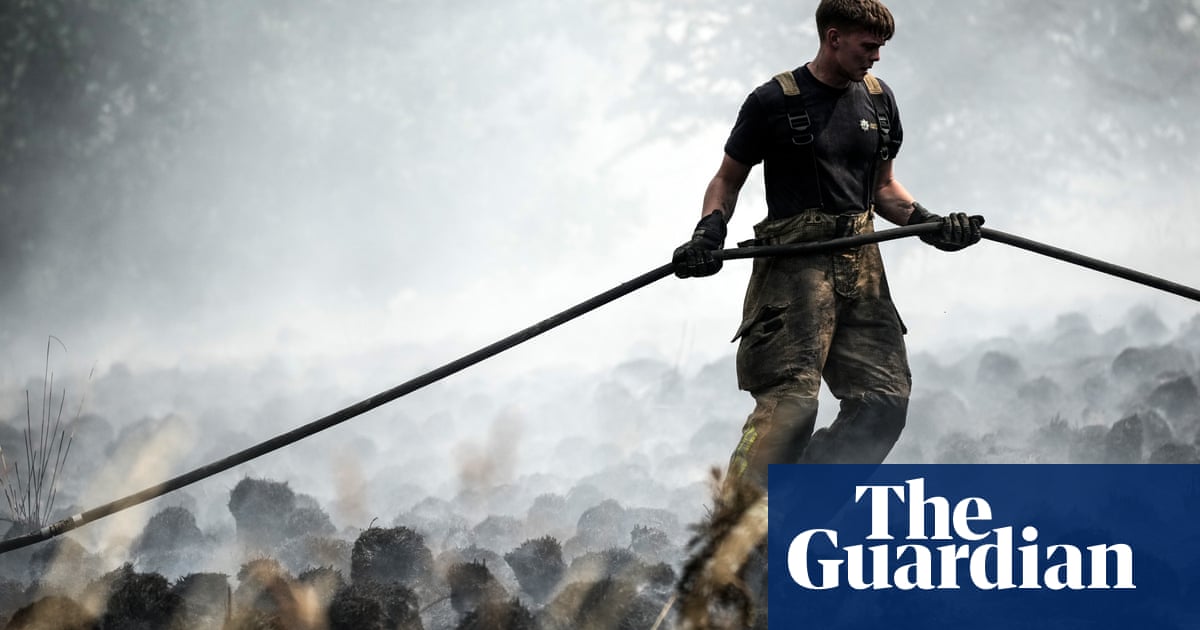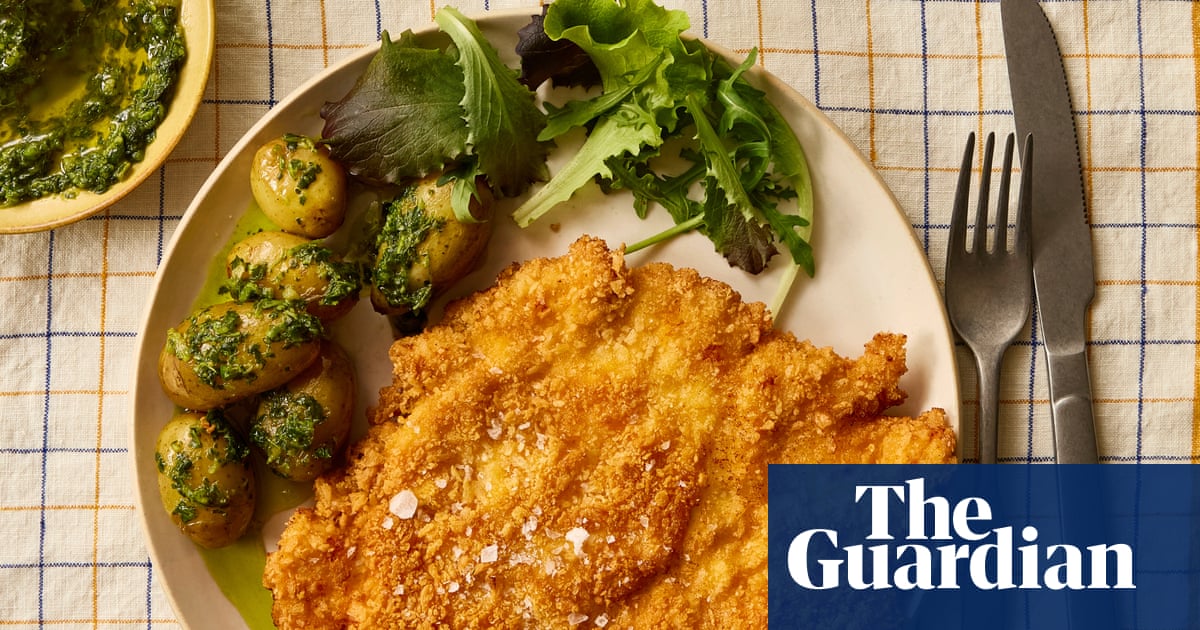Janelle Oombash stands on the smooth ice of an outdoor rink, keeping score and watching the time as two teams of teenagers run across the ice, whacking a ball with sticks under the afternoon sun. Outside the rink, a bonfire crackles, keeping spectators warm as they watch the game.
Broomball has been played for more than a century in northern Ontario. The game is similar to hockey, but players use a ball instead of a puck and wear specialized shoes rather than skates. Now 31, Oombash started playing the game at age 11. Her dad is a coach and taught her to play. “It’s a big sport. Everybody plays broomball or hockey,” she said.
Oombash organized today’s broomball tournament in Cat Lake First Nation, a remote Ojibway community of 650 people nestled about 500km north of Lake Superior as a way to encourage teenagers to socialize. She pointed at two boys on the same team. “These boys here, you would never see them talk. But in broomball, they can play together. They get along very well,” she said.

But these broomball games are becoming a rare occurrence. Cat Lake has no indoor arena, affording them only a few weeks of ice each winter. “We used to have tournaments every few weeks, but we haven’t been able to do that because the ice goes bad really early,” Oombash said. “It’s been disappointing.”
The outdoor rink opened in early February but then closed for a week due to warm temperatures, cancelling broomball and hockey practice for adults as they prepared to travel outside the community for competitive regional tournaments. “That was supposed to be the week we had practice, but we cut it because of how warm it was,” she explained. “We don’t know how long we’re going to have this ice.”
The climate crisis is piling increasing pressure on Indigenous communities’ constitutionally protected rights and traditions. Global heating is changing the migration patterns of animals that are crucial sources of food, and endangering sacred plants such as sage, burned in ceremonies, and black ash, used to weave baskets and make medicine.

In northern Ontario, warming temperatures are threatening wintertime events such as broomball, hockey, ice fishing and goose hunting. Shorter winter seasons and disappearing ice are forcing subarctic communities to adapt.
“I’m hoping they build an arena so we could play all year round,” Oombash said. “Because we all know the climate is going to change. We all know it’s going to get warmer and warmer.”
The landscape of northern Ontario consists of evergreen forests and spongy muskeg cut through by intertwined lakes and rivers. Dozens of remote First Nations are scattered across the north, accessible only by plane and thousands of kilometres of ice roads. In winter, the lakes freeze solid and snow cloaks the landscape, allowing people to travel overland to hunting camps.
Winter is prime hunting season in Eabametoong First Nation, a remote community of about 1,600 people. It’s the time of year that the lake surrounding the community freezes solid, enabling people to drive across and join family members in nearby communities for hunting trips.
In March, Eabametoong resident Martha Papah was looking forward to spending the weekend at her adult son’s hunting camp in the neighbouring community of Neskantaga. They planned to hunt beaver for meat and pelts, which can be made into blankets, hats or gloves. Beaver is a delicacy in winter because the animals haven’t yet had the chance to eat plants that make their meat bitter. “This time of year is good if you want to have beaver,” she said.
To reach Neskantaga, Papah must drive over an ice road that crosses a 5.5km-wide frozen lake, with ice that has become thinner and more treacherous in recent years. “I’m excited, and at the same time, you have to be on guard on the ice road. We drive really slow when we cross the lake. It’s dangerous for us,” she said.

There is no all-season road connecting the two communities and no direct flights. To visit her son without a winter road, Papah would need to fly 360km south to Thunder Bay, and then 420km north to Neskantaga, at a cost of C$1,500 round trip. “It’s much cheaper to go on the winter road,” she said.
Warmer temperatures are especially impacting the spring goose hunt. In fall, Canadian geese flock south in iconic V-shape formations, returning in spring to their northern breeding grounds. It’s the one time of year that geese gorge themselves to prepare for migration and breeding, which means more meat on the birds for hunters. This meat provides not only a traditional source of food, but an alternative to expensive groceries at the Northern Store.
In April, hunters and their families travel to camps, where they shoot geese and cook the meat over campfires. They typically travel by snowmobile across the frozen land. But in recent years, open water has appeared along the lakes and rivers, cutting off travel. “Global warming has disrupted every activity we do, like hunting for sustenance. So it’s becoming really difficult,” said Solomon Atlookan, Eabametoong’s chief.
“We used to go to our traditional territory way ‘til late April on a snowmobile, and we had a lot of snow,” he said. “In the last five years, none of us have gone there, to go spend a week and hunt geese during their migration, because there’s no snow.”
Eabametoong resident John Meeseetawaygeesic spends months each year out on the land, hunting, fishing and trapping – activities he shares on social media to followers all over the world. But travelling overland is riskier these days. “I have to be cautious, I have to take my time and have to be careful,” he said. “It’s not the way it used to be. Used to go anywhere before, but not now. You have to observe everywhere you go now. It’s dangerous now.”

He said the April goose hunt is more complicated now. “Because of the ice melting, we can’t really go anywhere. Years ago, when the ice was good and the snow was there, we would be everywhere. But now we can’t really do that because the ice has been melting too fast.”
He added that migration patterns of animals are changing. “We’re not catching anything, and now we don’t know where the animals are going.”
On 7 March, Meeseetawaygeesic boarded a small, 40-seat plane. He gripped the arms of his seat as the plane lifted off the short runway. These bumpy, low-flying planes make him nervous.
When he’s not hunting, Meeseetawaygeesic coaches the local men’s hockey team, Pick Your Poison. He and his teammates boarded the plane heading south to Thunder Bay, toward their final destination of Dryden, Ontario. Held in March every year, the Northern men’s hockey tournament in Dryden is the biggest event of the year for hockey teams in the north. “We’ve been hitting all the tournaments this winter, so I think we’re ready for the big one.,” Meeseetawaygeesic said.
The previous week, Pick Your Poison won a smaller tournament and used the prize money to pay for their flights. Normally, hockey players from northern communities drive south along ice roads to reach the big tournament, but these routes are becoming unreliable. A few nights earlier, Meeseetawaygeesic’s truck got stranded on a winter road. Warm temperatures made the road’s snowy surface softer than usual, and his truck became trapped in the snow. So they had to fly.

The winter roads that freeze each year make it cheaper for teams to travel to tournaments. But spring is arriving earlier each year, cutting short the winter road season. “With climate change, some of the reserves up north will have a hard time going home after the tournament next week because of the melting of the snow and ice,” he said.
To motivate his team, Meeseetawaygeesic tells them: “Play hard, play smart, have fun. Winning is not everything. Even losing is not everything. It’s a matter of being out there and enjoying yourself and meeting other people.” After arriving in Dryden, Pick Your Poison went on to win the championship in the B-side division.
This story was supported by the Pulitzer Center

 5 hours ago
8
5 hours ago
8













































